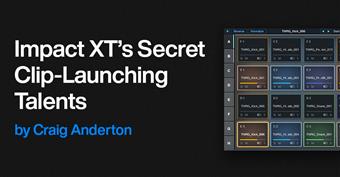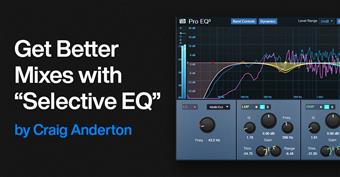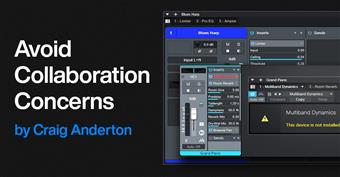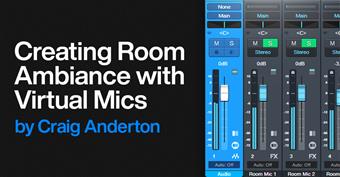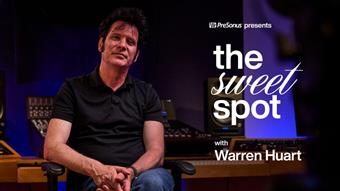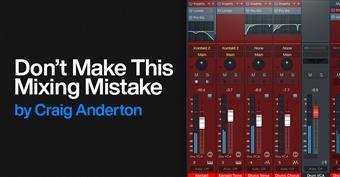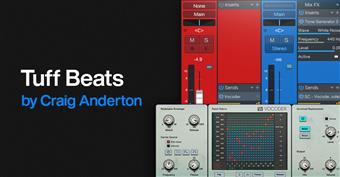
Ever wonder why inserting a particular plug-in makes the latency go through the roof? Which tracks you should transform because they require a lot of CPU power, and which ones aren't a problem? The Performance Monitor, accessed via View > Performance Monitor, reveals all
But this isn't just about interesting information. The Performance Monitor will help you decide which block settings to use, whether native low-latency monitoring will work for you, what level of dropout protection is appropriate, and more. Then, you can make intelligent tradeoffs to process audio in the most efficient way, while optimizing system stability.
Start at the the Top
Referring to fig. 1, the readout at the top indicates CPU and disk activity. Check this periodically to make sure you aren't running your CPU up against its limits. This can lead to audio crackles, dropouts, and other potential glitches. You can also set the level of dropout protection here.
Figure 1: The Performance Monitor window (the UI has been modified somewhat to make analyzing the data easier).
The Cache readout lets you know if you're wasting storage space. The Cache accumulates files as you work on a song, but many of these files are only temporary. If you invoke Cleanup Cache, Studio One will reclaim storage space by deleting all unused temp files in the cache. If you have lots of songs and haven't cleaned out their caches, you might be surprised at how much space this frees up. I usually wait until I'm done with a song before cleaning it up.
Finally, there's a list of all the plug-ins that are in use. The left-most column shows much relative CPU power a plug-in consumes, as a bar graph, and numerically. The next column to the right shows the plug-in name and format. The Type column shows whether the plug-in is an instrument or insert effect. The final column on the right shows the delay compensation a plug-in requires.
(Note there's also a column that shows the plug-in path, which is the track where the plug-in resides. For effects, it also shows the effect's position in the insert section. However, fig. 1 doesn't show this column, because it takes up space, and doesn't really apply to what we're covering.)
Figure 2: The transport shows useful performance information.
The transport includes a performance summary (fig. 2). Toward the lower left, you'll see meters for CPU consumption (top meter) and disk activity. Click on Performance to call up the Performance Monitor window. The circle of dots indicates writing activity to the cache. Also note the figure under the sample rate-this is the total time Studio One has added for plug-in compensation.
Analyzing the Data
I've altered the UI graphic a bit, by grouping plug-ins, and adding a line in between to separate the groups. This makes it easier to analyze the data.
The top group includes a variety of reverbs, which in general tend to consume a lot of CPU power. Waves Abbey Road Chambers, iZotope's Neoverb, and Rare Signals Transatlantic Plate clearly require the most CPU. Neoverb and Abbey Road Chambers also require the most latency compensation.
HD Cart is more efficient than I would have expected, and Studio One's reverbs give a good account of themselves. Open Air and Room Reverb in Eco mode are extremely efficient, registering only 01 on the CPU meter. However, bumping up Room Reverb to HQ mode registers 03.
Bear in mind that lots of CPU consumption doesn't mean a poor design-it can mean a complex design. Similarly, minimal CPU consumption doesn't mean the effect won't be as nuanced; it can simply mean the effect has been tightly optimized for a specific set of tasks. Also note that CPU-hungry reverbs are good candidates for being placed in an FX Channel or Bus. If used in individual tracks, Transform is your friend.
The next group down compares virtual instruments. You'll see a fair amount of variation. I didn't include the native Studio One instruments, because none of them requires delay compensation. Mai Tai and Presence typical register 01 or 02 in terms of CPU consumption, while the others don't move the CPU meter noticeably. Bottom line: if you want to have a lot of instruments in a project, use as many native Studio One versions as possible, because they're very efficient.
The next group down is plug-ins that use phase-linear technology. All of these require large amounts of delay compensation, because the delay is what allows for the plug-in to be in-phase internally. The Pro EQ2's reading (which alternates between 3 and 4) is for only the phase-linear stage enabled; the nonlinear EQ stages draw very little CPU power. This is what you would expect from an EQ that has to be efficient enough to be inserted in lots of tracks, as is typical in a multitrack project.
The next-to-the-last group is amp sims. The figures vary a lot depending on which amps, cabinets, and effects are in use. For example, the Guitar Rig 6 preset includes two of their new amps, in HQ mode, that use a more CPU-intensive modeling process. The PRS V9 doesn't have a lot of bells and whistles, but concentrates on detailed amp sounds-hence the high CPU consumption. Ampire is somewhat more efficient than most high-quality amp sims, but there's no avoiding the reality that good amp sims consume a lot of CPU power-which is another reason to become familiar with the Transform function.
Finally, the last group shows why even with today's powerful computers, there's a reason why people add Universal Audio's DSP hardware to their systems. Both the Manley Massive Passive and Shadow Hills compressor draw a lot of power, and require significant delay compensation. But, they don't draw any power from Studio One, because they get their power from UA's DSP cards, not your computer'
More from PreSonus
19/04/2024
By Craig Anderton
Impact XT can launch clips, which is great for songwriting (see the blog post Songwriting with Impact XT). But few people realize that Impact...
12/04/2024
By Craig Anderton
Good mixes often depend on carving out a unique sonic space for each instrument, so you can hear them clearly. Sometimes carving out that spa...
05/04/2024
By Craig Anderton
MIDI guitars are a niche product, because the learning curve can be daunting for some guitar players. However, I'm surprised how many pro...
29/03/2024
By Craig Anderton
As the universe of Studio One users grows, so do opportunities for collaboration. But your collaborator may not be using the same version of ...
22/03/2024
By Craig Anderton
Over three years ago, I wrote a blog post on how to make a drumcoder. Its design was somewhat like a vocoder-drum audio served as a modulat...
15/03/2024
By Craig Anderton
One of Atmos's coolest features is scalability. No matter how complex your Atmos project may be, you can render it as Binaural, 5.1, 5.1....
13/03/2024
Watch the Brooklyn Synthpop duo remix their song Blame in Studio One
Less than 24 hours after meeting each other, producer Luke Moellman and vocalist Jon San...
10/03/2024
By Craig Anderton
The impetus behind this design was wanting to add envelope flanging to amp sims like Ampire. But there's a problem: most amp sim outputs ...
01/03/2024
By Craig Anderton
Supplementing close-miking techniques with room mics gives acoustic sounds a life-like sense of space. Typically, this technique involves pla...
27/02/2024
Notion Mobile v3 took mobile music creation to the next level with support for iOS, Android, Windows, Fire OS and macOS. Now v3.3 adds many enhancements and fix...
26/02/2024
Logic's Grammy-nominated producer breaks down his Sweet Spot.
Before he found success as an avant-garde hip hop producer, 6ix was just 30 units shy of a de...
25/02/2024
The Grammy-nominated multi-Platinum producer breaks down his Sweet Spot.
From the studio with chart-topping artists like Aerosmith and The Fray, to empowering ...
23/02/2024
By Craig Anderton
Do you think of mixes in absolute terms, or relative terms? Knowing the difference, and when to apply which approach, can make a huge differe...
16/02/2024
By Craig Anderton
Calling all beats/hip-hop/EDM/hard rock fans: This novel effects starts with drums modulating the Vocoder's white noise carrier, and take...
09/02/2024
This tip is about working with stereo, NOT about Dolby Atmos or surround-but we're going to steal some of what Atmos does to reinvent stereo panning. Stud...
07/02/2024
The GRAMMY-winning recording and mix engineer shows us how he uses Studio One to create an artful immersive mix.
Jeff Ellis is a force to be reckoned with. The...
02/02/2024
Presence's sound library includes a fine acoustic 12-string guitar, but not an electric one. So, perhaps it's not surprising that one of the more popula...
26/01/2024
At first, this might not seem too exciting. But follow the directions below, and try comping using this method-I don't think you'll be disappointed. Thi...
19/01/2024
You know the feeling: You're tracking or doing an overdub with a virtual instrument or amp sim, but you're frustrated by the excessive latency inherent ...
12/01/2024
Recording audio using more than one feed from the same source may create phase issues. For example, when miking a bass amp and taking a DI (dry) input, the DI&#...
05/01/2024
If you haven't experimented yet with mid-side stereo miking, you'll be in for a treat when you do. Here's why:
Record background singers with gorge...
29/12/2023
This complements the tip Better Ducking for Voiceovers and Podcasts and the tip Why I Don't Use Compression Anymore. It applies the concept of voiceover duc...
22/12/2023
Engineers sometimes advocate using high-pass filters to clean up the low end and tighten the sound. Others believe that because of issues inherent in highpass...
20/12/2023
The GRAMMY-nominated artist, producer, and songwriter shows us how he uses Studio One to cook a musical idea from scratch.
Josh Cumbee is a triple threat: The ...
15/12/2023
This wasn't a conscious decision, or something I planned. But when I looked through my last few songs while seeking candidates for a book's screenshots,...
08/12/2023
First, a follow-up: In the October 13 tip about creating Track Presets for parallel processing, I mentioned that Track Presets can't include buses, which is...
01/12/2023
Vocoder's aren't normal effects. For example, Arturia's Vocoder V is an effect/instrument hybrid, because it's an audio effect that includes a...
24/11/2023
For over a decade, stereo and mono vinyl records co-existed before the transition to stereo was complete. During that time, many records were released in both m...
17/11/2023
Strings can enhance almost any genre of music-and with a little more effort, you can do string arrangements that go beyond simply adding a string pad preset. So...
10/11/2023
Since Dynamic EQ was introduced in version 5, I've used it to replace and improve some techniques I used to do with static EQ. For example, I'm a fan of...
03/11/2023
Gregor Beyerle recently posted a video called Producer vs. Engineer-What's the Difference?, which had quite a few comments. It seems most people feel that f...
27/10/2023
Sending too many low frequencies through reverb gives a bloated, muddy sound. This is one reason why you'll rarely see a send from a bass track going into r...
20/10/2023
While trying to do something else with Melodyne, I stumbled on this way to add depth or tightness to drum sounds-quickly and easily. Here's the sound of an ...
13/10/2023
Parallel processing splits a signal into two or more parallel channels. Bi-amping is a common example of parallel processing:
One channel processes low frequen...
06/10/2023
Everyone talks about the importance of Dolby Atmos for post-production, but the implications go further than that. Atmos really does change how you create and ...
29/09/2023
You don't need a massive surround system with speakers wired all over your studio to create immersive audio. Whether you want surround or Dolby Atmos mixes...
22/09/2023
By Craig Anderton
Background music or environmental sounds are usually an essential part of commercials, movies, presentations, podcasts, and more. When doing ...
15/09/2023
The post Mixing la Studio One had a great response, so here's another tip that relates more to making better music than making better-sounding music. We&#...
08/09/2023
This FX Chain's inspiration is the Tilt filter circuit created by Tonelux designer Paul Wolff. First used in the Tonelux MP1A mic preamp, the Tilt filter h...
01/09/2023
But first, some breaking news: Version 1.5 of The Huge Book of Studio One Tips and Tricks is now available from the PreSonus shop. Like previous versions, it�...
25/08/2023
Studio One 6.2 reworked Layer and Take handling, and some of the new functionality is exceptionally useful. For example, suppose you want to record comp vocals ...
18/08/2023
We haven't done a boutique digital effect for Studio One Professional in a while, so let's use a plugin in a totally wrong way-yet end up with somethi...
11/08/2023
MIDI drum loops have a bad rap, because some musicians consider them metronomic and boring. But they don't have to be. Subtly leading or lagging the beat at...
04/08/2023
Ask 100 recording engineers about their approach to mixing, and you'll hear 100 different answers. Here's mine, and how this approach relates to Studio ...
28/07/2023
FL Studio is a cool program. Yet when some users see me working with Studio One's features like comping tools, harmonic editing, the lyrics track, Mix FX, M...
21/07/2023
Bass has a tough gig. Speakers have a hard time reproducing such low frequencies. Also, the ear is less sensitive to low (and high) frequencies compared to midr...
18/07/2023
Notion Mobile v3 took mobile music creation to the next level with support for iOS, Android, Windows and macOS. Now v3.2 adds many enhancements and fixes, as we...
14/07/2023
First, an announcement: If you own the eBook How to Record and Mix Great Vocals in Studio One, you can download the 2.1 update for free from your PreSonus acc...
07/07/2023
Let's transform your acoustic piano instrument sounds-with effects that showcase the power of Multiband Dynamics. Choose from two download links at the end ...
24/06/2023
Acoustic drum loops freeze-dry a drummer's playing-so, what you hear is what you get. What you get. What you get. What you get. What you get. What you get.
...
 Ever wonder why inserting a particular plug-in makes the latency go through the roof? Which tracks you should transform because they require a lot of CPU power, and which ones aren't a problem? The Performance Monitor, accessed via View > Performance Monitor, reveals all
Ever wonder why inserting a particular plug-in makes the latency go through the roof? Which tracks you should transform because they require a lot of CPU power, and which ones aren't a problem? The Performance Monitor, accessed via View > Performance Monitor, reveals all













